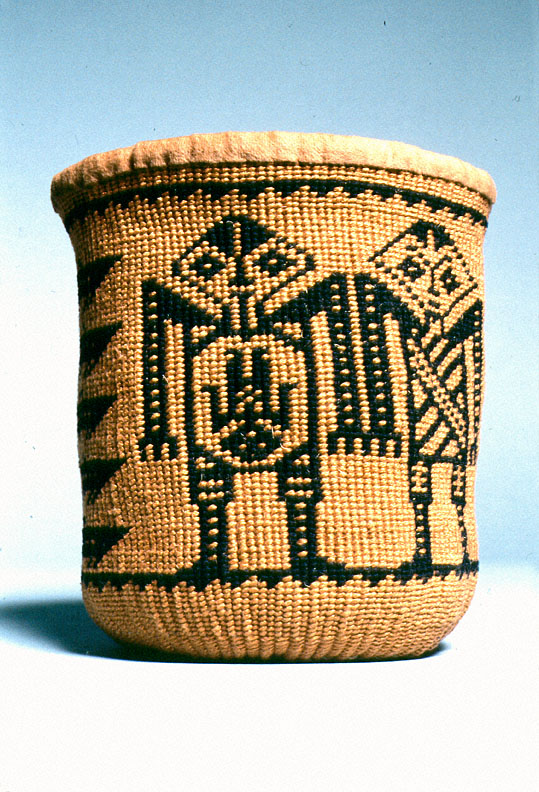This Wasco Sally Bag, named “Sturgeon Greet the Babies,” was made by Pat Courtney Gold, a member of the Wasco Nation of the Confederated Tribes of the Warm Springs Reservation. According to Gold: “There are two pregnant couples on the basket. The human images represent our Wasco ancestors. The babies are the next generation, thereby continuing our culture. The sturgeon between the couples represent strength and long life, which are gifts to the babies.” The basket was woven with jute warps and cotton wefts.
Pat Courtney Gold first studied traditional Wasco-style Sally bags, woven with a rare full-turn twining technique, in 1991. That year, Gold, her sister Bernyce Courtney, and Arlene Boileau studied with Mary Schlick through the Traditional Arts Apprenticeship Program of the Oregon Historical Society Folklife Program. Within a year, Gold left her career as a mathematician and computer specialist and established a business (Sally Sisters) with her sister in Scappoose, Oregon with the goal of revitalizing the traditional practice of weaving Wasco-style baskets. Since then, she has become internationally known for her exquisite, award-winning work. Gold explains, “When I weave a basket, it’s an emotional and rewarding experience, because I know it is not just for my personal development―it is for the generations that missed it, and it’s also for the generations that are coming after me. This is a spiritual and very beautiful experience for me.”
Sally bags, known as wapaas and aqw’alkt respectively among the Wasco and Wishxam people, are woven with a unique full-turn twining method long practiced by Native Americans of the mid-Columbia River region. The baskets were used primarily by women engaged in gathering roots and medicines during the digging season, but they were also used to gather nuts, seeds, and mushrooms. Traditional human figures and animal motifs, such as frogs, condors, dogs, salmon, and sturgeon adorned these highly valued baskets, making them easily distinguishable from other basketry styles. Prior to contact with Euro Americans in the early nineteenth century, the baskets were constructed primarily of dogbane (Apacynum cannabinum, also known as Indian hemp); after contact, they were often made with manufactured cotton, hemp, or jute twines.
Knowledge of the full-turn twining technique was nearly lost in 1971 with the death of Louise Van Pelt Sconawah Spino, then the only known basket maker using the traditional Wasco-style weaving method. However, through the effort of tribal elders from the Yakama and Warm Springs reservations, Mary Schlick, and her apprentices, the artform has survived and been revitalized. Today, artists like Gold and her sister are preserving the use of traditional figures and motifs in their baskets. At the same time, they are infusing baskets with new images and social commentary—much like their ancestors before them had done.
Further Reading:
Schlick, Mary Dodds. Columbia River Basketry: Gift of the Ancestors, Gift of the Earth. Seattle, Wash., 1994.
Hunn, Eugene S. with James Selam and family. Nich’i Wána, “The Big River:” Mid-Columbia Indians and their Land. Seattle, Wash., 1991.
Written by Joshua Binus, © Oregon Historical Society, 2005.


